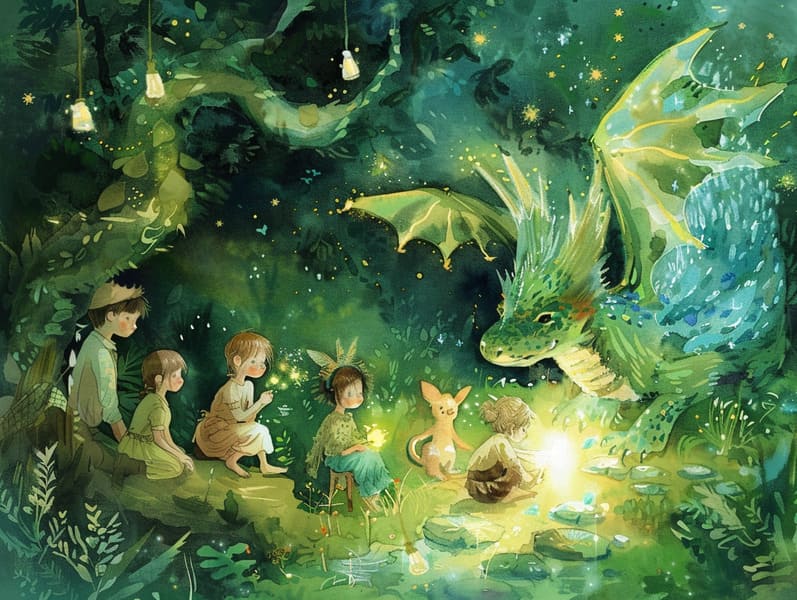
Classic fairy tales have long histories. These tales have been passed down from one generation to the next ages before they were ever written down. They originated from a variety of backgrounds, including Western traditions. They were initially narrated among older generations, often carrying themes and messages related to the societal norms and beliefs of the time.
The famous Grimm duo, Jacob and Wilhelm, were among the first to compile many of these beloved tales. Their anthology, "Grimm's Fairy Stories," included stories like "The Little Glass Slipper," "Hansel and Gretel," and "Little Snow White," which have since become mainstays in the world of children's fairy tales. Similarly, Hans Andersen's fantastical narratives, such as "The Sea Maid," and "The Little Duckling," have stolen hearts worldwide, guaranteeing their place in the pantheon of beloved fairy tales.
Despite their age, fairy tales remain as applicable as ever, especially as nighttime stories for kids. These enchanting tales are now available in multiple formats, including richly illustrated books, whimsical animations, and internet fairy tales.
Their enduring popularity can be traced to several whimsical characteristics:
Vital Lessons: Ancient fairy tales often whisper important moral lessons. Tales like "The Story of the Boy Who Cried Wolf" teach the merit of truthfulness, while "The Story of the Tortoise and the Hare" stress the qualities of determination and humbleness. These tales offer kids clear distinctions between right and wrong, building their moral compass in a mild yet important way.
Empathy and Awareness: Fairy tales frequently illustrate beings facing challenges and problems, prompting kids to comprehend with their struggles and celebrate their triumphs. For instance, "The Story of Beauty and the Beast" highlights the merit of seeing beyond looks to realize the inner core of a being, developing empathy and understanding.
Cultural Insights: Many classic fairy tales are deeply ingrained in the cultural contexts from which they grew. Engaging with these fairy tales can provide delightful insights into different societies, cultivating a sense of cultural respect and perception.
Creativity and Imagination: The supernatural elements in classic fairy tales—enchanted lands—stimulate children’s fantasy worlds. These fairy tales carry readers to supernatural realms, fostering inventive dreams and a sense of amazement that lasts a lifetime.
Timeless fairy tales are not only alluring but also educational. They work as charming tools in nurturing various intellectual and emotional capacities in the young. When timeless fairy tales are read aloud, they nurture linguistic abilities by offering new lexicon and detailed sentence structures. This practice also improves auditory skills and mindfulness, as children focus on every detail, anticipating to see what happens next.
Furthermore, contemplating the themes and characters of ancient fairy tales can cultivate thinking skills and evaluative skills. Little ones are taught to see patterns, guess what will happen, and grasp cause and effect. These discussions also assist kids utter their thoughts and feelings, promoting their emotional intelligence.
In today’s information age, the abundance of online storybooks has made these stories check here more within reach than ever. Online platforms and web apps feature broad selections of Grimm's fairy tales that can be looked at or listened via anytime, anywhere. Fairy tales recited are particularly in demand, sharing an captivating way for children to delight in these mesmerizing stories. Audiobooks and spoken videos guide characters and settings to life, often supplemented by charming musical scores and background music that improve the tale journey.
The timeless charm of ancient fairy tales lies in their ability to modify to current times while sustaining their key morals. Contemporary takes of these stories often present more different protagonists and modern settings, making them understandable to today’s audience. However, the core values of heroism, charity, and fair-mindedness remain unchanged, continuing to influence young readers of all ages.
Old fairy tales also offer a sense of serenity and familiarity. They serve a well-structured narrative with a recognizable beginning, middle, and end, often closing with the conclusion of conflicts and the triumph of justice over injustice. This foreseeability can be comforting for the young, extending a sense of steadfastness in an always shifting world.
Ancient fairy tales continue to allure and edify new generations, maintaining their wonder and importance in modern society. As nighttime stories for kids, they highlight a perfect blend of delight and instruction, cultivating moral values, empathy, and creativity. The accessibility of web-based fairy tales and the commonness of fairy tales told out loud assure that these traditional tales remain attainable to new generations.
By protecting and broadcasting these stories, we continue to value the rich tapestry of inventiveness and cultural heritage. Whether you are enjoying a vibrantly illustrated book, browsing a internet library, or listening on an voice book, the appeal of old fairy tales is always within reach. These stories emphasize of the lasting presence of stories and its ability to draw us together across eras and regions.
Whether you are perusing a colorful picture book, delving into a virtual library, or listening on an voice book, the elegance of famous fairy tales is always within reach.
These tales point out of the persistent essence of stories and its ability to bind us across time and space, weaving a spell that fascinates and enlightens alike.
Comments on “Delving into the Background of Popular Fairy Tales with the Everlasting Elegance.”